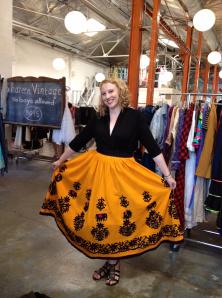
Millennial Thrift Shopping
My daughter Katie often sends me pictures of her fabulous vintage finds like a folkloric skirt from the 50s or a cocktail dress from the 60s. She is one of many milliennials regularly frequenting shops that specialize in vintage, retro and thrift clothing.
One of the shops Shareen Vintage of Los Angeles describes their vintage wonderland as the creative center of a secret society of women who love to be at the cutting edge of fashion trends. In their store, clothing is divided by decades, starting in the 1920s through the 1990s, providing a living retrospect to fashion. Another store Re-mix Classic Vintage Footwear actually started out selling vintage shoes, but when demand outpaced their stock, they began having their own 20s – 50s vintage designs manufactured for women demanding more of the vintage looks.
Millennials have embraced Thrift Style, a fashion movement that incorporates several trends with their desire to be an individual. Research by Ypulse shows that 36% of Millennials find thrift shopping cool and 56% of Millennials say that thrift shopping is a great way to find cheap and unique clothes.
Six Key Trends Shaping Millennial Shopping
1. The end of conspicuous branding and the rise of personal style. Some 55% of people between 13 and 34 say they don’t follow trends. Millennials want to stand out and prize individualism over “fitting in.” With access to global stores like Abercrombie and Fitch are having problems enticing millennials because their fashions are seen as ubiquitous and too high priced for their taste. A big logo is no longer a coveted status symbol. Finding something completely original is the goal of trendsetters today. A thrift store find is both unique and rare. Even celebrities have contributed to the vintage culture by wearing vintage couture to big events like the Oscars and Grammys.
2. Saving money is cool. There is no surprise that 60% of millennials worldwide feel personally influenced by the economic crisis. So the ability to save money and find a personl look are added bonuses of thrift shopping. Shoppers pride themselves on smart finds at great prices. In fact, because of the durability of the items, they are actually seen as an investment in higher quality goods.
3. Sustainability. There is a decided movement against the “disposable culture” of throwaway plastic bags and planned obsolescence of electronics. Shoppers don’t really care if their retail purchases are over-wrapped or put into paper or plastic for transport. They are fine with foregoing some of the traditional trappings of the retail environment. Vintage items are often seen as being constructed better and made out of high quality fabrics. And the ability to recycle things of the past helps cutdown on their personal footprint in society.
4. Nostalgia for better times. In an unconscious way, milllennials are drawn to simpler times. Those who lived during the first Strawberry Shortcake period remember it with fondness and positive memories. For those who did not experience the 50s and 60s, the vintage look recalls a time of stability and lack of stress. Here in Nashville you can buy and experience a little slice of Grand Ole Opry history by just shopping at Katy’s Western Wear.
5. Personalization and DIY. Personal style means personalization. And, influenced by programming such as Project Runway, millennials turn to online sites such as Etsy and eBay for fun finds. These shoppers and designers can express their own creativity by reworking clothes with sewing, knitting, embellishing and dying their finds. Some 22% of Millennials say they often modify, cut up or embellish their clothing.
6. Purchases with a Purpose. Thrift stores are getting a millennial makeover to appeal to young shoppers who like to shop with a purpose. The idea that the YWCA can help women, Goodwill trains disadvantaged for retail jobs or ThriftSmart actually gives their proceeds to real charities is an appealing proposition to millennials who want to make a difference in the world around them.
Retailers and marketers alike need to understand the way Millennials shop and how best to appeal to their interests.

